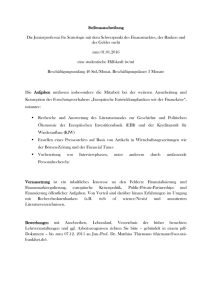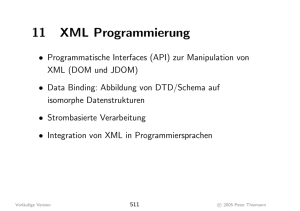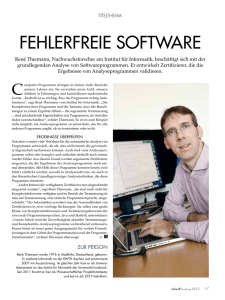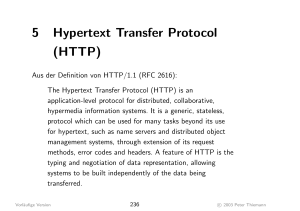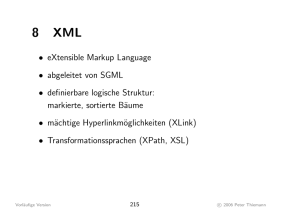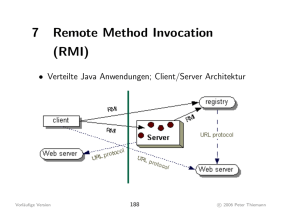Programmierung für das Internet
Werbung
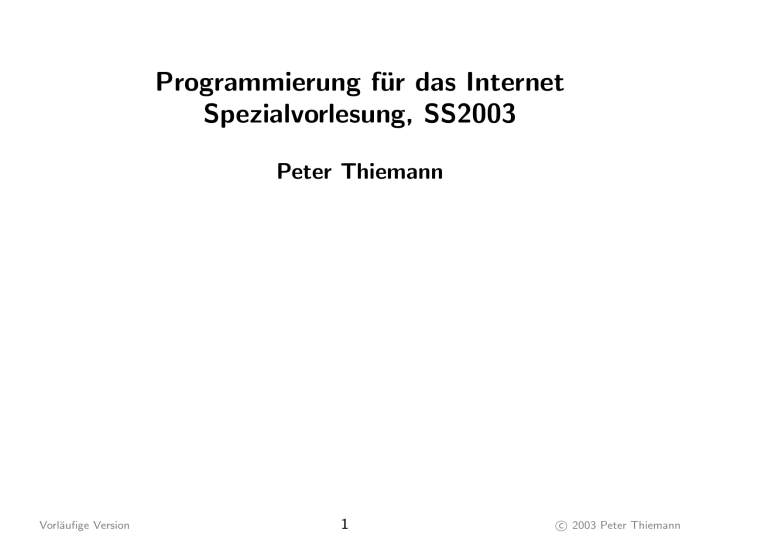
Programmierung für das Internet Spezialvorlesung, SS2003 Peter Thiemann Vorläufige Version 1 c 2003 Peter Thiemann Übersicht • Einführung • Web – Skripting mit WASH – HTTP – CGI – JavaScript – XML – XML Verarbeitung mit HaXml Vorläufige Version 2 c 2003 Peter Thiemann • Mail – Terminologie und Formate – WashMail – SMTP – RMS – IMAP Vorläufige Version 3 c 2003 Peter Thiemann • Vermischtes (nach Zeit/Interesse) – DNS – Sicherheit: TLS – XML Transformation (XSLT, XDUCE, . . . ) – Populäre Protokolle: PPP, DHCP – Formale Systeme: Service Combinators, Ambient Calculus Vorläufige Version 4 c 2003 Peter Thiemann Zu WASH, WashMail, HaXml • embedded DSLs (domain specific languages) • Bibliotheken für Haskell • Haskell ist funktionale Programmiersprache ⇒ kurze Einführung im Rahmen der Vorlesung ⇒ mehr dazu im nächsten Semester • restlicher Inhalt ist nicht von Haskell abhängig, dient aber zT als Vehikel • siehe Umfrage auf Webseite der Vorlesung Vorläufige Version 5 c 2003 Peter Thiemann Übungen, Prüfungen, Webseite • Dipl.-Inform. Matthias Neubauer • in der Regel montags 17–18 • Aufgaben in Teams zu bearbeiten – Programmieraufgaben (z.T. Haskell-spezifisch) – Experimente • Abschlussprüfung mündlich in Teams auch Fragen zu den Ü-Aufgaben • Webseite der Vorlesung http://proglang.informatik.uni-freiburg.de/teaching/ss2003/internet/ Vorläufige Version 6 c 2003 Peter Thiemann 1 Das Internet • globales Kommunikationssystem • Verbindungen zwischen angeschlossenen Endgeräten unicast Rechner — Rechner oder multicast ein Rechner — viele Rechner • einheitlicher Adressraum (Internet-Adressen, Domainnamen) Vorläufige Version 7 c 2003 Peter Thiemann 1.1 Geschichte 1969: ARPANET (4 Hosts, 50kb/s) 1973: Netzwerkprotokoll TCP/IP (Vinton Cerf, Bob Kahn) Kommunikation zwischen Netzwerken 1974: Name “Internet” 1976: Ethernet (Bob Metcalfe) 1979: USENET/News 1981: ARPANET, CSNET (213 Hosts) 1983: DNS (562 Hosts) 1988: (56000 Hosts) Vorläufige Version 8 c 2003 Peter Thiemann 1990: Hypertext-System von Tim Berners-Lee (CERN) 1992: Gründung der Internet Society World-Wide-Web Artikel veröffentlicht “Surfing the Internet” (Jean Armour Polly) (1.136.000 Hosts) 1993: Mosaic Browser 1994: Netscape Browser W3C am MIT gegründet http://www.w3c.org/ erste kommerzielle Anwendungen: Pizzabestellung, First Virtual, Shopping Malls (3.864.000 Hosts) Vorläufige Version 9 c 2003 Peter Thiemann 1995: 6.642.000 Hosts 1998: > 30.000.000 Hosts 2000: 10.910.395 DNS Einträge, 2003: 19.087.254 DNS Einträge aber dynamische (Mehrfach-) Nutzung! Quelle: http://www.ripe.net/statistics/hostcount.html Vorläufige Version 10 c 2003 Peter Thiemann 1.2 Organisation • dezentral und offen • Festlegung von Protokollen und Standards durch Vorschlag, Implementierung und Bekanntmachung ISOC IAB IETF Vorläufige Version IANA 11 IRTF c 2003 Peter Thiemann 1.2.1 The Internet Society http://www.isoc.org/ The Internet Society is a non-profit, non-governmental, international, professional membership organization. It focuses on: standards, education, and policy issues. Vorläufige Version 12 c 2003 Peter Thiemann 1.2.2 Internet Architecture Board http://www.iab.org/iab/ The Internet Architecture Board (IAB) is a technical advisory group of the Internet Society. Its responsibilities include: 1. IESG Selection: The IAB appoints a new IETF chair and all other IESG candidates, from a list provided by the IETF nominating committee. 2. Architectural Oversight: The IAB provides oversight of the architecture for the protocols and procedures used by the Internet. 3. Standards Process Oversight and Appeal: The IAB provides oversight of the process used to create Internet Standards. The IAB serves as an appeal board for complaints of improper execution of the standards process. 4. RFC Series and IANA: The IAB is responsible for editorial management and publication of the Request for Comments (RFC) document series, and for administration of the various Internet assigned numbers. 5. External Liaison: The IAB acts as representative of the interests of the Internet Society in liaison relationships with other organizations concerned with standards and other technical and organizational issues relevant to the Vorläufige Version 13 c 2003 Peter Thiemann world-wide Internet. 6. Advice to ISOC: The IAB acts as a source of advice and guidance to the Board of Trustees and Officers of the Internet Society concerning technical, architectural, procedural, and (where appropriate) policy matters pertaining to the Internet and its enabling technologies. IESG Internet Engineering Steering Group IANA Internet Assigned Numbers Authority Vorläufige Version 14 c 2003 Peter Thiemann 1.2.3 The Internet Engineering Task Force http://www.ietf.org/ The Internet Engineering Task Force is a loosely self-organized group of people who make technical and other contributions to the engineering and evolution of the Internet and its technologies. It is the principal body engaged in the development of new Internet standard specifications. The IETF meeting is not a conference, although there are technical presentations. The IETF is not a traditional standards organization, although many specifications are produced that become standards. The IETF is made up of volunteers who meet three times a year to fulfill the IETF mission. Vorläufige Version 15 c 2003 Peter Thiemann IETF’s mission includes: • Identifying, and proposing solutions to, pressing operational and technical problems in the Internet; • Specifying the development or usage of protocols and the near-term architecture to solve such technical problems for the Internet; • Making recommendations to the Internet Engineering Steering Group (IESG) regarding the standardization of protocols and protocol usage in the Internet; • Facilitating technology transfer from the Internet Research Task Force (IRTF) to the wider Internet community; and • Providing a forum for the exchange of information within the Internet community between vendors, users, researchers, agency contractors and network managers. Vorläufige Version 16 c 2003 Peter Thiemann RFC http://www.ietf.org/rfc.html IETF gibt RFCs (Request for Comments) heraus. Diese beschreiben (meist) Protokolle (nicht Datenformate wie z.B. das W3C). Sie durchlaufen einen Standardisierungsprozess. Manche werden zu Standards. Anforderungen an ein RFC Vorläufige Version 17 c 2003 Peter Thiemann 1.3 Protokolle Protokoll Spezifikation der Struktur einer Kommunikation OSI-ISO Standard definiert 7 Protokollschichten mit festgelegten Aufgaben: 1. Bitübertragung 2. Sicherung 3. Vermittlung 4. Transport 5. Kommunikation 6. Darstellung 7. Anwendung Praktisch verwendet: Internet Protokoll RFC 791 Vorläufige Version 18 c 2003 Peter Thiemann 1.3.1 Beispiel: HTTP (Hypertext Transfer Protocol) client (Webbrowser) Server (Webserver) GET / HTTP/1.1 Host: localhost HTTP/1.1 200 OK Date: Web, 03 May 2000 19:41:20 GMT Server: Apache/1.3.9 (Unix) Last−Modified: Wed, 20 May 1998 14:59:42 GMT ETag: "4405−656−3562efde" Accept−Ranges: bytes Content−Length: 1622 Content−Type: text/html Vorläufige Version 19 c 2003 Peter Thiemann 1.3.2 Beispiel: SMTP (Simple Mail Transfer Protocol) Client (Mail User Agent) Server (Mailserver) 220 foo.com ready EHLO bar.com 250−8BITMIME 250−SIZE 250−DSN 250 HELP MAIL FROM: <[email protected]> 250 OK Vorläufige Version 20 c 2003 Peter Thiemann 1.3.3 Low-level Internet Protokolle Datenpaket = Folge von Oktetten Paketversand (UDP – User Datagram Protocol) • Verbindungsaufbau • Versenden eines Datenpakets (unidirektional) • Verbindungsabbau Vorläufige Version 21 c 2003 Peter Thiemann Virtuelle Verbindung stream connection (TCP/IP – transmission control protocol / internet protocol) strombasierte Verbindung, d.h. keine feste Länge • Verbindungsaufbau • verlässliche bidirektionale Verbindung – Bündelung zu Paketen – Paketbestätigung – Paketverlust – Reihenfolge • Verbindungsabbau Vorläufige Version 22 c 2003 Peter Thiemann 1.3.4 Dienste (Services) • Protokolle auf höherer Abstraktionsebene • meist aufbauend auf TCP/IP • meist Client-Server Struktur selten: Peer-to-peer Protokolle z.B. für Filesharing (edonkey, gnutella, freenet, etc) Vorläufige Version 23 c 2003 Peter Thiemann Ein Rechner – mehrere Dienste • Auswahl durch Portnummern (16 Bit) oder Servicenamen (vgl. /etc/services; RFC 1700) • Well Known Ports: 0 – 1023 Server muss vom Administrator gestartet warten • Registered Ports: 1024 – 49151 Keine Restriktion bzgl. Server • Dynamic/Private Ports: 49152 – 65535 Vorläufige Version 24 c 2003 Peter Thiemann 1.3.5 Beispiele für Dienste Telnet RFC 0854 Virtuelle Terminals für Remote Login (viele Erweiterungen, seit 1972) Server: telnetd Client: telnet; telnet hHost i hPortnummer i mit Verschlüsselung: ssh bzw. sshd (mit anderem Protokoll) Vorläufige Version 25 c 2003 Peter Thiemann E-mail Versendung von E-mail: SMTP (Simple Mail Transfer Protocol) RFC 2821 Format einer E-mail: RFC 2822 Erweiterte Mail Inhalte: MIME (Multipurpose Internet Mail Extensions) RFC 2045 – RFC 2049 uva Server: sendmail oder ein anderer MTA (Mail Transfer Agent) Client: mail oder ein anderer MUA (Mail User Agent), z.B. emacs, pine, netscape, mh, . . . Vorläufige Version 26 c 2003 Peter Thiemann File Transfer Protocol (FTP) • Transport von Dateien • RFC 0959 und viele Erweiterungen • seit 1971 RFC 0114 • Persönlicher Modus: Account (Name/Passwort) auf Server erforderlich • Anonymer Modus (anonymous FTP): jeder kann zugreifen Server: ftpd Client: ftp, . . . Vorläufige Version 27 c 2003 Peter Thiemann WWW Hypertext Transfer Protocol (HTTP 1.1) RFC 2616 • Erweiterbares Protokoll zur Übertragung und Manipulation von getypten Dokumenten • Adressierung der Dokumente durch URIs (Uniform Resource Identifiers) Server: Apache, CERN, NCSA, MS IIS, Jigsaw, . . . Clients: mozilla, netscape, msie, amaya, wget, . . . Vorläufige Version 28 c 2003 Peter Thiemann URI RFC 1630: This document defines the syntax used by the World-Wide Web initiative to encode the names and addresses of objects on the Internet. The web is considered to include objects accessed using an extendable number of protocols, existing, invented for the web itself, or to be invented in the future. Access instructions for an individual object under a given protocol are encoded into forms of address string. Other protocols allow the use of object names of various forms. In order to abstract the idea of a generic object, the web needs the concepts of the universal set of objects, and of the universal set of names or addresses of objects. Vorläufige Version 29 c 2003 Peter Thiemann Spezielle URIs • Uniform Resource Locator (URL) RFC 1738; RFC 1808, RFC 2368, . . . – Symbolische Adresse für ein Dokument (Objekt) – Enthält spezifische Zugriffsinformation, d.h. Rechnernamen, Passwörter, etc – Format: hSchema i:hschemaspezifische Information i – Beispiele: http://www.informatik.uni-freiburg.de/proglang ftp://ftp.informatik.uni-freiburg.de/iif mailto:[email protected] Vorläufige Version 30 c 2003 Peter Thiemann • Uniform Resource Name (URN) RFC 2141 – Eindeutiger Name für ein Dokument (Objekt) – Impliziert globalen Namensraum und Persistenz – Namensraum verwaltet durch IANA http://www.iana.org/assignments/urn-namespaces – Format: urn:hNI i:hNSS i NI — Namespace Identifier (assigned by IANA) NSS — Namespace Specific String – Beispiel: urn:ietf:rfc:2141 urn:ietf:std:50 urn:ISSN:1560-1560 urn:newsml:iptc.org:20001006:NewsMLv1.0:1 urn:newsml:reuters.com:20000206: IIMFFH05643_2000-02-06_17-54-01_L06156584:1U Vorläufige Version 31 c 2003 Peter Thiemann 1.3.6 Webservices • Protokolle auf Anwendungsebene • meist aufbauend auf HTTP • Client-Server Struktur • interaktive Anwendungen mit Webbrowser als GUI Vorläufige Version 32 c 2003 Peter Thiemann Webscripting C A B Vorläufige Version 33 c 2003 Peter Thiemann
